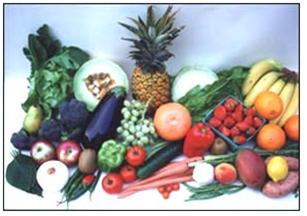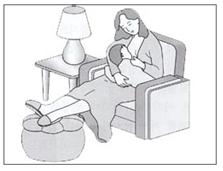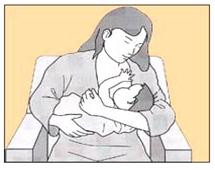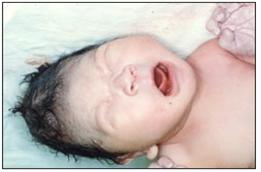생후 1주 이후부터 1, 2, 3 개월까지 모유 수유, Breastfeeding in the first 1, 2, 3 months age infants after the first week
표 3-4. 생후 2개월 된 한국 영아들의 체중과 신장의 백분위수
|
백분위수 성별 |
3 | 10 | 25 | 50 | 75 | 90 | 97 | |
| 남아 | 체중(kg) | 4.50 | 5.15 | 5.70 | 6.20 | 6.74 | 7.26 | 8.00 |
| 남아신장(cm) | 55.2 | 57.4 | 59.0 | 61.0 | 62.4 | 64.3 | 66.6 | |
| 여아 | 체중(kg) | 4.20 | 4.90 | 5.30 | 5.80 | 6.30 | 7.00 | 7.70 |
| 여아신장(cm) | 53.8 | 56.0 | 58.0 | 59.8 | 61.6 | 63.4 | 65.3 |
소스: 부모도 반의사가 되어야 한다―소아가정간호백과 제 3권

사진 40. 과일류, 채소류 음식물, 단백질류 음식물, 곡물류 음식물 등 균형 잡히고 영양가가 골고루 들어있는 음식물을 충분히 섭취하고, 육체적·정신적으로 충분히 휴식을 취하면서 모유를 수유하고 젖 먹는 아기의 체중이 적절하게 증가되면 젖이 잘 나오고 모유 수유도 성공적으로 하고 있다고 본다. Copyright ⓒ 2012 John Sangwon Lee, MD., FAAP
- 분만 후 첫 2개월 동안은 하루에 8~12번 모유를 수유 한다.
- 대략 1.5~3시간 간격으로 수유한다.
- 물론 모유 수유도 식이 의술에 속하기 때문에 모든 아기가 다 일률적으로 똑같은 식으로 젖을 먹지 않는다.
- 대부분의 수유모가 모유 수유하기 바로 전 젖이 젖꼭지에서 뚝뚝 떨어지거나 한쪽 젖을 먹일 때 다른 쪽 유방에서 젖이 줄줄 흘러나오는 현상을 경험한다.
- 매번 모유 수유 할 때는 한쪽 젖을 10~20분 동안, 양쪽 젖을 다 먹이는 데는 20~40분이 소요된다.
- 하루에 한 번 밤 동안 모유를 수유한다.
- 밤에 4~6시간 동안 깨지 않고 계속 자는 아기들의 젖 먹는 횟수는 적어진다. 그 대신 낮 동안 젖 먹는 횟수가 더 많아진다.
- 한편 낮에 3~4시간 정도 깨지 않고 계속 낮잠을 잔 아기들은 오랫동안 낮잠을 자는 동안 수유를 못하고 낮 동안 수유 횟수가 적어진다. 그러나 잠자는 동안 먹지 못한 1일 모유 총수요량을 보충하기 위해 깨어 있는 동안에 더 자주 먹을 수 있다.
- 생후 1~2개월 동안, 밤에 6시간 이상 젖을 먹지 않고 계속 자는 아기들이나 하루 24시간 동안 8회 이하 모유를 먹는 아기들은 체중이 정상적으로 증가되지 않을 수 있다.
- 충분한 젖을 먹는 아기들의 대부분은 1일 8번 이상 소변을 본다.
- 만삭으로 태어난 신생아의 출생 시 체중은 생후 2~7일까지 생리적으로 6~7% 정도 감소됐다가 적어도 생후 2주까지 출생 시 체중 치로 되돌아가는 것이 보통이다.
- 모유를 먹는 아기의 체중이 적어도 생후 2주까지 출생 시 체중 치로 되돌아가면 모유가 충분히 분비되고 아기가 모유를 충분히 섭취하고 있다고 간접적으로 알려주는 것이다.
- 생후 7~14일부터는 신생아의 체중이 1주 120~210g 증가하는 것이 보통이다.
- 이미 언급했지만, 아기들은 보통 노란 고추씨 덩어리와 비슷한 변이 섞인 물똥을 하루에 적어도 한 번 본다. 때로는 하루에 5~6번 정도 정상적으로 볼 수 있다.
- 또는 2~3일에 한번 정상적으로 모유 변을 볼 수 있다. 드물게는 모유를 수유하자마자 똥을 쌀 수 있다.
- 이 때 일부의 아기들에게 일유 현상이 생길 수 있다. 즉 생리적 위식도 역류가 생겨 먹은 모유를 가끔 넘길 수 있다. 이런 현상은 점점 더 성장함에 따라 점차 덜 해 지다가 생후 1세가 되기 전에 더 이상 생기지 않는 것이 보통이다.
- 신생아들이나 영아들은 여러 가지 원인으로 울 수 있다. 아기의 울음은 아기의 말이다.
- 배가 고프거나 피로하거나 무엇을 빨고 싶다거나 안아주기를 원하거나 어디가 아프거나 배 속에 가스가 차거나 기저귀가 젖거나 춥거나 덥거나 불편할 때 엄마 아빠보고 같이 놀아달라고 요구 할 때 울음 말로 의사를 소통한다.
- 확실한 이유는 모르지만 밤에는 아기들이 더 보채는 것이 일반적이다.
- 아기가 울 때마다 우는 원인을 확실히 모르고 모유를 자꾸 수유해서는 안 된다. 그러나 초보 엄마들은 아기가 울면 모유가 부족해서 운다고 생각해 밤에 모유 수유를 더 자주한다.
- 어떤 수유모는 젖이 부족하다고 판단하고 모유를 수유 하고 거기다가 보충용으로 인공영양을 더 먹이기도 한다.
- 생후 1~2개월 된 아기들의 일부는 보통보다 더 오래 울고 어디가 아픈 것 같고 자주 보채는 증상징후가 밤낮으로 얼마동안 생길 수 있다. 이런 증상징후를 영아산통 또는 산통(Infantile colic)(p00참조)이라고 한다. 이 때 어떤 부모들은 아기들이 “폐를 더 건강하게 하기 위해 그렇게 운다.”고 한다. 그 말은 옳은 말이 아니다.
- 아기의 울음은 범세계적 공통 언어이고 아기가 하고 싶은 의사를 표현 하는 울음 말이다.
- 아기가 울 때마다 항상 안아주는 초보 엄마들도 많다.
- 이렇게 양육하는 것은 아기가 혼자서 독립해 나가는 독립 추구심을 연마하는 기회를 주지 않는 것과 마찬가지다.
- 아기도 혼자서 누워 조용히 쉬고 싶은 때가 있다. 혼자 노래를 부르고 싶을 때가 있다. 엄마나 아빠의 포근한 품에 안겨 있고 쉽지 않은 때도 있다. 아기가 운다고 무조건 안아주고 먹이는 것은 때로 아기의 독립 추구 력을 부정하는 육아가 될 수 있다.
- 물론 아기를 아무리 많이 안아주고 사랑해 준다고 해서 아기의 버릇이 나빠지지는 않는다. 조건 없는 진정한 사랑을 아무리 많이 해준다고 해서 버릇이 더 나빠지지도 않는다. 다만, 아기가 말하고 싶은 것이 무엇인지 세심하게 관심 기울일 필요가 있다.
- 어쩌면 아기들은 이런 말을 하고 있는지도 모른다.
- “엄마, 아빠, 내가 비록 미숙하고 연약하지만 독립된 한 인간이라는 것을 인정해 주세요.
- 그러나 나는 엄마 아빠의 사랑과 보살핌이 꼭 필요해요”라고. 그들이 필요로 하는 것을 채워주고, 그들을 안정하게 양육하면 그들도 울지 않고 다른 사람들을 신뢰하는 아이로 잘 자라날 것이다. 부모도 반의사가 되어야 한다 ―소아가정간호백과-제22권 아들 딸 이렇게 사랑해 키우세요-사랑 참조.

그림 41. 모유 수유를 하는 동안 수유모가 편안한 자세로 모유 수유를 하는 것이 좋다. 수유모 자신이 스트레스를 받거나 휴식을 충분히 취하지 않고 걱정을 많이 하면 모유 분비가 잘되지 않는다.
Copyright ⓒ 2012 John Sangwon Lee, MD., FAAP

그림 42. 분만 후 2개월 동안은 1일 8~12번 정도 모유를 수유하는 것이 보통이다.
Copyright ⓒ 2012 John Sangwon Lee, MD., FAAP

사진 2-56. 갓 태어난 아기가 첫 숨을 쉬면서 운다.
이 아기는 배가 고파서 우는 것이 아니다.
Copyright ⓒ 2012 John Sangwon Lee, MD., FAAP
Breastfeeding in the first 1, 2, 3 months age infants after the first week
Table 3-4. Percentiles of weight and height of 2-month-old Korean infants
표 3-4. 생후 2개월 된 한국 영아들의 체중과 신장의 백분위수
|
percentile Gender |
3 | 10 | 25 | 50 | 75 | 90 | 97 | |
| boy | weight (kg) | 4.50 | 5.15 | 5.70 | 6.20 | 6.74 | 7.26 | 8.00 |
| height(cm) | 55.2 | 57.4 | 59.0 | 61.0 | 62.4 | 64.3 | 66.6 | |
| girl | weight (kg) | 4.20 | 4.90 | 5.30 | 5.80 | 6.30 | 7.00 | 7.70 |
| height (cm) | 53.8 | 56.0 | 58.0 | 59.8 | 61.6 | 63.4 | 65.3 |
Source: Parents Should Be Anti-Doctors – Encyclopedia of Pediatric and Family Nursing Vol. 3

Photo 40. Eat enough balanced and nutritious foods such as fruits and vegetables, protein foods, and grain foods, and get enough rest physically and mentally. If it is increased, milk production is good and breastfeeding is successful. Copyright ⓒ 2012 John Sangwon Lee, MD., FAAP
• Breastfeed 8 to 12 times a day for the first 2 months after delivery.
• Feed approximately every 1.5 to 3 hours.
• Of course, breastfeeding is also part of the diet, so not all babies are uniformly fed the same way.
• Most breastfeeding mothers will experience dripping milk from the nipple right before breastfeeding or dripping from the other breast when feeding.
• Each time you breastfeed, it takes 10-20 minutes for one breast and 20-40 minutes for both breasts.
• Breastfeed once a day overnight.
• Babies who continue to sleep without waking for 4 to 6 hours at night will breastfeed less frequently. Instead, they breastfeed more frequently during the day.
• On the other hand, babies who take a nap without waking up for 3 to 4 hours during the day are unable to breastfeed during a long nap, and the number of feedings during the day decreases. However, babies can eat more often while babies are awake to make up for the total daily milk demand that they missed while they were sleeping.
• During the first 1 to 2 months of age, babies who continue to sleep without breastfeeding for more than 6 hours at night or who are breastfed 8 times or less in 24 hours a day may not gain weight normally.
• Most breastfed babies urinate at least 8 times a day.
• It is common for full-term newborns to lose 6-7% of their birth weight physiologically by 2-7 days after birth, and then return to their birth weight by at least 2 weeks after birth.
• When a breastfed baby’s weight returns to its birth weight by at least 2 weeks of age, it is an indirect indication that sufficient breast milk is being secreted and that the baby is getting enough breast milk.
• From the 7th to the 14th day after birth, it is normal for the weight of a newborn to increase by 120 to 210g per week.
• As already mentioned, babies usually see water poop with feces similar to lumps of yellow chili seeds at least once a day. Sometimes you can see normally 5 to 6 times a day. • Or you can pass breast milk normally once every 2-3 days. Rarely, you may poop as soon as you are breastfeeding.
• At this time, some babies may experience one-sidedness. In other words, physiological gastroesophageal reflux may occur, and the breast milk that has been eaten may occasionally be passed. These symptoms become less common as they grow older and usually no longer occur before the age of 1 year.
• Newborns and infants can cry for a variety of reasons. A baby’s cry is a baby’s word.
• Communicate by crying when you ask Mom and Dad to play with you when you are hungry or tired, want to suck on something, want a hug, have an ailment, gas, diaper wet, cold, hot or uncomfortable
• For unknown reasons, it is common for babies to be more irritable at night.
• You should not continue to breastfeed without knowing why your baby cries every time he or she cries. However, new mothers believe that when their baby cries, they cry because of insufficient milk, so they breastfeed more often at night.
• Some breastfeeding mothers feel that they lack milk and breastfeeding, plus artificial nutrition as a supplement.
• Some babies who are 1 to 2 months old cry longer than usual and may have frequent signs of soreness and frequent flushing for some time during the day and night. These symptoms are called infantile colic or infantile colic. At this time, some parents say that their babies “cry to make their lungs healthier.” That is not correct.
• A baby’s cry is a universal language, and it is a cry that expresses a baby’s wishes.
• There are many new mothers who always give a hug whenever their baby cries.
• Parenting like this doesn’t give your baby an opportunity to hone his independent pursuit of independence.
• There are times when babies want to lie down and rest quietly on their own. There are times when “I want to sing by myself”. There are times when it is not easy being held in the warm arms of Mom or Dad. Unconditionally hugging and feeding a baby when she cries can sometimes be parenting that denies the baby’s ability to seek independence.
• Of course, no matter how much hugs and love you give your baby, it doesn’t make your baby’s habit bad. No matter how often you give out true unconditional love, it doesn’t worsen your habit. However, you need to pay close attention to what the baby wants to say.
• Maybe babies are saying these things.
• “Mom, Dad, please acknowledge that I am an independent human being, though immature and fragile.
• But I need Mom and dad’s love and care”. If you provide them with what they need and raise them safely, they too will grow up to be trustworthy children who don’t cry.
www.drleepediatrics.com-Volume 22, Raising Your Sons and Daughters with Love Like This.

Figure 41. It is recommended that the mother breastfeeds in a comfortable position while breastfeeding. She said that if the nursing mother herself is stressed or worried about not getting enough rest, she will not be able to produce enough breast milk. Copyright ⓒ 2012 John Sangwon Lee, MD., FAAP

Figure 42. It is normal to breastfeed 8 to 12 times a day for two months after delivery. Copyright ⓒ 2012 John Sangwon Lee, MD., FAAP

Picture 2-56. A newborn baby cries with her first breath. This baby isn’t crying because he’s hungry. Copyright ⓒ 2012 John Sangwon Lee, MD., FAAP
출처 및 참조문헌
- www.drleepediatrics.com 제1권 소아청소년 응급 의료
- www.drleepediatrics.com 제2권 소아청소년 예방
- www.drleepediatrics.com 제3권 소아청소년 성장 발육 육아
- www.drleepediatrics.com 제4권 모유,모유수유, 이유
- www.drleepediatrics.com 제5권 인공영양, 우유, 이유식, 비타민, 미네랄, 단백질, 탄수화물, 지방
- www.drleepediatrics.com 제6권 신생아 성장 발육 육아 질병
- www.drleepediatrics.com제7권 소아청소년 감염병
- www.drleepediatrics.com제8권 소아청소년 호흡기 질환
- www.drleepediatrics.com제9권 소아청소년 소화기 질환
- www.drleepediatrics.com제10권. 소아청소년 신장 비뇨 생식기 질환
- www.drleepediatrics.com제11권. 소아청소년 심장 혈관계 질환
- www.drleepediatrics.com제12권. 소아청소년 신경 정신 질환, 행동 수면 문제
- www.drleepediatrics.com제13권. 소아청소년 혈액, 림프, 종양 질환
- www.drleepediatrics.com제14권. 소아청소년 내분비, 유전, 염색체, 대사, 희귀병
- www.drleepediatrics.com제15권. 소아청소년 알레르기, 자가 면역질환
- www.drleepediatrics.com제16권. 소아청소년 정형외과 질환
- www.drleepediatrics.com제17권. 소아청소년 피부 질환
- www.drleepediatrics.com제18권. 소아청소년 이비인후(귀 코 인두 후두) 질환
- www.drleepediatrics.com제19권. 소아청소년 안과 (눈)질환
- www.drleepediatrics.com 제20권 소아청소년 이 (치아)질환
- www.drleepediatrics.com 제21권 소아청소년 가정 학교 간호
- www.drleepediatrics.com 제22권 아들 딸 이렇게 사랑해 키우세요
- www.drleepediatrics.com 제23권 사춘기 아이들의 성장 발육 질병
- www.drleepediatrics.com 제24권 소아청소년 성교육
- www.drleepediatrics.com 제25권 임신, 분만, 출산, 신생아 돌보기
- Red book 29th-31st edition 2021
- Nelson Text Book of Pediatrics 19th- 21st Edition
- The Johns Hopkins Hospital, The Harriet Lane Handbook, 22nd edition
- 응급환자관리 정담미디어
-
소아가정간호백과–부모도 반의사가 되어야 한다, 이상원
-
Neonatal Resuscitation American heart Association
-
Neonatology Jeffrey J.Pomerance, C. Joan Richardson
-
Pediatric Resuscitation Pediatric Clinics of North America, Stephen M. Schexnayder, M.D.
-
Pediatric Critical Care, Pediatric Clinics of North America, James P. Orlowski, M.D.
-
Preparation for Birth. Beverly Savage and Dianna Smith
-
Infectious disease of children, Saul Krugman, Samuel L Katz, Ann A. Gershon, Catherine Wilfert
- 소아과학 대한교과서
- Other
-
Copyright ⓒ 2015 John Sangwon Lee, MD., FAAP
“부모도 반의사가 되어야 한다”-내용은 여러분들의 의사로부터 얻은 정보와 진료를 대신할 수 없습니다.
“The information contained in this publication should not be used as a substitute for the medical care and advice of your doctor. There may be variations in treatment that your doctor may recommend based on individual facts and circumstances. “Parental education is the best medicine.”